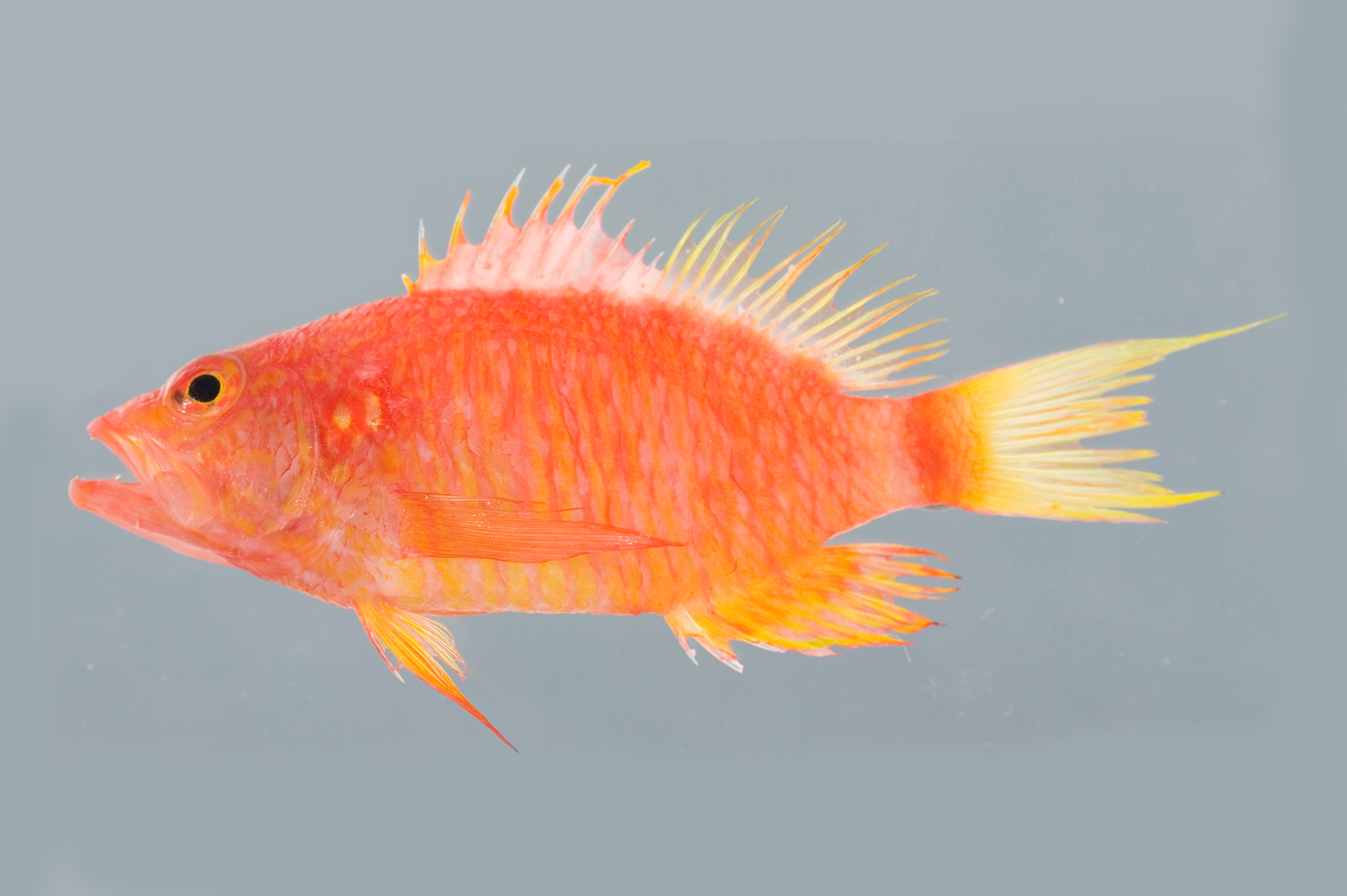Bloody Perchlet, Plectranthias cruentus Gill & Roberts 2020

Holotype of the Bloody Perchlet, Plectranthias cruentus, AMS I.42725-007, 57.3 mm SL, from off Balls Pyramid near Lord Howe Island in the Tasman Sea, depth 86-89m. Source: Robin McPhee & Kerryn Parkinson / NORFANZ Founding Parties. License: All rights reserved
Summary:
A bright orange perchlet becoming yellow-orange below, with narrow, red-edged pink oblique bars across the side that also extend along the anal-fin base, a broad orange-red bar on the rear of the caudal peduncle, and a yellow caudal fin.
Cite this page as:
Bray, D.J. 2021, Plectranthias cruentus in Fishes of Australia, accessed 02 Jul 2025, https://fishesofaustralia.net.au/Home/species/5430
Bloody Perchlet, Plectranthias cruentus Gill & Roberts 2020
More Info
|
Distribution |
Lord Howe Province off Balls Pyramid and Lord Howe Island in the Tasman Sea, and possibly off Moreton Bay, Queensland. |
|
Features |
Dorsal fin X,16-17; Anal fin III,7-8; Pectoral fin 13; Caudal fin principal rays 9+8, branched rays 7+7, procurrent rays 5-6; Lateral-line scales 29-30; vertebrae 10+16. Predorsal scales extend anteriorly only to the supratemporal canal, at a vertical above the preopercle. |
|
Colour |
Fresh coloration: Head and body bright orange, becoming bright yellow-orange ventrally; two indistinct red-edged pink stripes beneath eye extending to first infraorbital, one from mid-ventral edge of orbit, the other from posterior edge of orbit; scales on cheek each with red-edged pink spot, these aligning to form three oblique stripes that extend, respectively, to pelvic fin origin, space between bases of pelvic and pectoral fins, and lower edge of pectoral-fin base; operculum with two large (subequal to pupil) red-edged, bright yellow spots; iris red, with short dark bar anteriorly, bright yellow spots ventrally and posteriorly and narrow yellow ring around pupil; scales of dorsal body each with a pink spot, these aligning on the lateral and ventral body to become narrow, red-edged pink oblique bars, each alternating with c.15 slightly oblique yellow bars, narrow dorsally, expanding to at least twice the width ventrally, extending to ventral profile of body and across anal fin; caudal peduncle with a distinctive broad vertical orange-red bar near caudal base, edged anteriorly with contrasting broad pale pink bar, and orange-yellow posteriorly; spinous portion of dorsal fin pale pink, spine tips and fleshy tabs bright orange-yellow to bright yellow; soft rays of dorsal fin yellow, becoming bright orange-yellow distally and narrowly pale pink basally; basal part of dorsal fin with five indistinct reddish orange blotches, first between 5-6th spines, second between 8-9th spines, third between 1-5th segmented rays, fourth between 7-10th segmented rays, fifth between 12-17th segmented rays; anal rays bright yellow, red on distal margin, with red bars on body extending on to base of fin, breaking up to become one (anteriorly) to three (posteriorly) rows of red streaks; caudal fin orange-yellow basally, becoming pale yellow posteriorly, with upper and lower margins of fin narrowly red; pelvic fin spine orange-red, the remainder of fin bright orange-yellow basally, becoming bright orange-red distally, with distal tip black; pectoral fin translucent reddish orange. |
|
Similar Species |
Plectranthias cruentus differs from the similar Plectranthias pelicieri (from New Caledonia) in having: some middle pectoral-fin rays branched (versus all unbranched in P. pelicieri), the fifth or sixth dorsal-fin spine longest (versus third longest), and interopercle with 1–3 small, inconspicuous serrations (versus distinctly serrate anteriorly). P. cruentus also differs from P. pelicieri in live coloration: caudal fin yellow (versus clear with yellow or orange spots in P. pelicieri); operculum with two red-edged yellow pupil-sized spots (versus with a single eye-sized red and yellow ocellus); and posterior part of caudal peduncle with broad orange-red bar (versus pink with orange-red spots or rectangular markings dorsally and ventrally). |
|
Etymology |
The specific name cruentus is from the Latin cruor (= stained or spotted with blood) in reference to the bright red markings of this species. |
|
Species Citation |
Plectranthias cruenta Gill & Roberts 2020, Zootaxa 4750(4): 561, Figs. 1-2. Type locality: off Balls Pyramid, Lord Howe Island, Australia, 31°49.11'S, 159°20.74'E - 31°49.44'S, 159°20.39'E, depth 86-89 m. |
|
Author |
Bray, D.J. 2021 |
|
Resources |
Bloody Perchlet, Plectranthias cruentus Gill & Roberts 2020
References
Clark, M.R. & Roberts, C.D. 2008. Fish and invertebrate biodiversity on the Norfolk Ridge and Lord Howe Rise, Tasman Sea (NORFANZ voyage, 2003). New Zealand Aquatic Environment and Biodiversity Report No. 28. 131 pp. (as Plectranthias sp. C)
Gill, A.C., Pogonoski, J.J., Moore, G.I. & Johnson, J.W. 2021. Review of Australian species of Plectranthias and Selenanthias Tanaka (Teleostei: Serranidae: Anthiadinae), with descriptions of four new species. Zootaxa 4918(1): 1-116 https://doi.org/10.11646/zootaxa.4918.1.1
Gill, A.C. & Roberts, C.D. 2020. Plectranthias cruentus, a new species of anthiadine perchlet (Teleostei: Serranidae) from the Lord Howe Rise, Tasman Sea. Zootaxa 4750(4):560-566 http://dx.doi.org/10.11646/zootaxa.4750.4.6
Williams, A., Gowlett-Holmes, K. & Althaus, F. 2006. Biodiversity survey of seamounts and slopes of the Norfolk Ridge and Lord Howe Rise. Final Report to the Department of the Environment and Heritage (National Oceans Office), i-vi + 1 - 203, Append. 1 - 8. (as Plectranthias sp. C)




